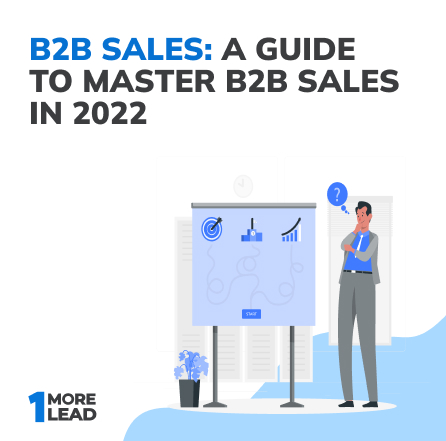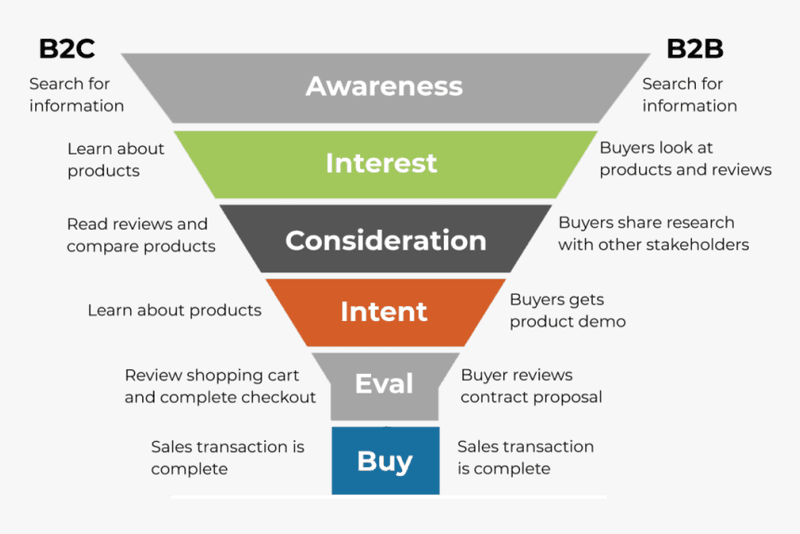
Whether a long time expert or a fresh-faced newbie, we all need to refresh our knowledge at times. In this article, we’ll go back to basics and look into what B2B Sales are and answer any questions you may have.
In the simplest of terms, 'B2B sales' is short for business-to-business sales. It’s a process where one business makes a commercial transaction with another. This can occur in several circumstances. For instance:
B2B Sales is distinct and different from B2C sales — business-to-consumer sales — which are instances where businesses conduct transactions with individuals.
Market research company Forrester’s findings show the estimated total size of the US B2B sales market was around $9 trillion in 2018 with B2B eCommerce accounting for $1.1 trillion. They’ve also predicted that US B2B eCommerce will hit a whopping $1.8 Trillion by 2023. Similar statistics for US B2C sales show that US B2C eCommerce sales only added up to $512 billion in 2018—less than half the value of the B2B market.
There are, of course, similarities between the two, such as:
But for our purposes, we also need to look at why the B2B market is so large when compared to the B2C market and how the sales process differs between the two?
Loosely defined, the sales process is a series of steps — a journey, if you will — that a buyer goes through before they commit to making a purchase. In B2B or B2C sales, the salesperson’s job is to guide as many buyers as they can to the end of the sales process and complete a sale.
So, what does a B2B sales process look like?

We can simplify the B2B sales process to look like the simple funnel above, which is pretty much exactly the same as a B2C sales funnel, except that the finer details of the steps are different.
All sales funnels describe the journey from awareness when a potential buyer is first made aware of a product or service, all the way to purchase when the transaction is completed. It’s the marketing team’s job to make prospects aware of the product/service and make sure that their interest is piqued. The sales team will take over from there and guide the buyers through the funnel and complete the purchase.
But while the sales funnel illustrates the buying process as a linear journey, it must be understood that it is a simplified model that does not always accurately portray real-life scenarios. Buyers can and will enter and leave the funnel at different stages; sometimes they make complete purchases directly after they become aware of it without ever speaking to a sales rep. What must be understood is that they can move between stages at will.
However, the funnel still remains an excellent method to visualize the steps a buyer takes to purchase, even though it is not as inflexible as it used to be several decades ago. Which leads to our next question:
The biggest change in the B2B sales process over the last decades is easily the fact that buyers are taking more control of the sales process than they ever did before. In fact, the millennial generation and Generation Z that follow them are very involved and carry out a lot of initial research before committing to a purchase.
These digital natives have become integrated into the decision-making process at their companies and the data from Forrester shows that about 68% of B2B buyers prefer to do their research independently online, using social media and review sites as their primary source of information, which can reduce the effectiveness of old-school marketing and sales tactics.
After they conduct their own research, the buyers will identify the companies they wish to reach out to, visit these companies’ websites and move along the sales funnel at their pace. Which leads to the biggest question that needs to be asked, how can B2B sales reps still have an actual impact in the modern version of the buyer’s journey?
Cold calling isn’t quite dead. However, it might be getting there soon because it is not anywhere near as effective as it used to be. As buyers have become savvier, businesses have to adapt their strategies for both B2B and B2C sales. New and more subtle ways to connect with potential buyers include methods such as:
Introduced by the Miller Heiman Group, strategic selling is a tactic that focuses on helping businesses win complex deals with an insights-driven, scalable approach. The core of this approach lies in being able to identify different points of contact at the buyer’s company and estimating their influence on the sales process. Then the salesperson can adjust how they approach each point of contact and communicate with them to ensure that the final sale goes through smoothly.
Solution selling focuses more on the needs of the prospect more than it does on the actual product or service being sold. In this strategy, the salesperson needs to identify and diagnose the needs of the potential buyer, their challenges, and goals and recommend products or services that can help them overcome these challenges and meet their goals.
Global research and advisory firm Gartner predicted that account-based selling would be adopted by 75% of B2B businesses by 2019. This strategy is focused on treating every single account as a market of one. Salespeople select target accounts, investigate and identify their needs, craft an approach that promotes personalized values of the product or service being sold and reaching out.
As previously stated, Forrester’s statistics show that 68% of B2B customers research on search engines and social media before making a purchase. Social selling focuses on social media to identify and engage with prospects. The goal of social selling is to build a relationship with prospect companies as the first step of selling and understanding their needs. In today’s market, this approach involves using social media platforms like LinkedIn, Twitter, Facebook, and others to share relevant content in order to engage potential buyers or nurture existing ones.
As many tactics as there might be, B2B salespeople, don’t need to go about doing all of their jobs on their own. With more and more buyers conducting research independently, sales reps need to be more competent at identifying these buyers and selling to them. While this might sound like an impossible task, it doesn’t have to be.
There are many tools and services that exist that can help B2B sales teams deal with the modern market by generating sales leads from anonymous website visitors. These tools work by utilizing website visitor identification software to let sales reps see the visitors who browse their website, identify key decision-makers and proactively make contact.
OneMoreLead is one such service.
It is a fact that the people who visit a website are more likely to make a purchase than someone who has never heard of the company, which means that every single visitor should be important to the sales team. With OneMoreLead’s help, businesses can ensure that they don’t let ready-to-buy leads escape.
OneMoreLead can give sales teams valid, useful data that can allow companies to reach out to the right contacts and beat their competitors to the sale. In fact, with OneMoreLead, sales teams can expect up to 147% faster conversion to sales. With more than 40+ million 100% verified B2B prospects to search from, any sales team is bound to find the perfect match for their product or service.
B2B sales is something that has evolved a lot and is still undergoing a lot of change. Technology is the biggest disrupter and it has given a lot of power to the consumers — which is not a bad thing by any measure, but it does mean that sales teams and sales reps also need to stay on their feet and up-to-date with modern methods. Fortunately, that is not hard, what with specialized tools and technology available for use by sales teams. Using these tools, such as OneMoreLead, sales teams can take initiative while still providing a valuable experience to their prospective buyers and see their efforts succeed.